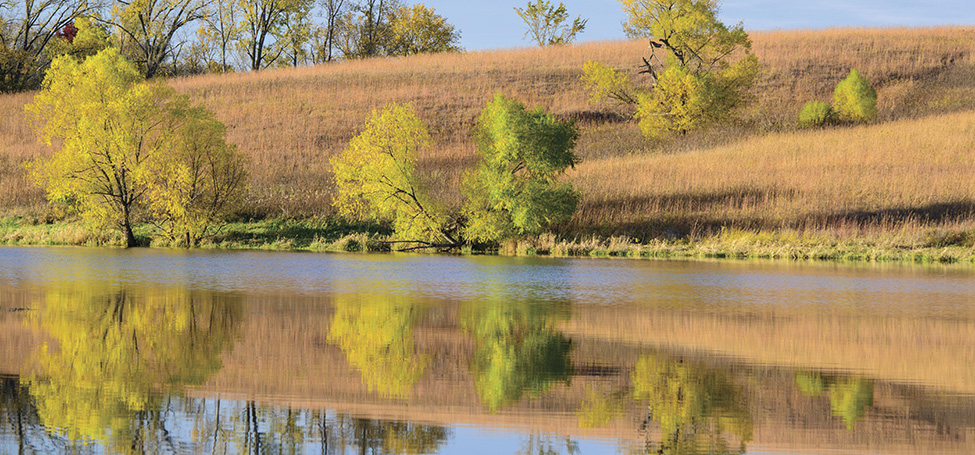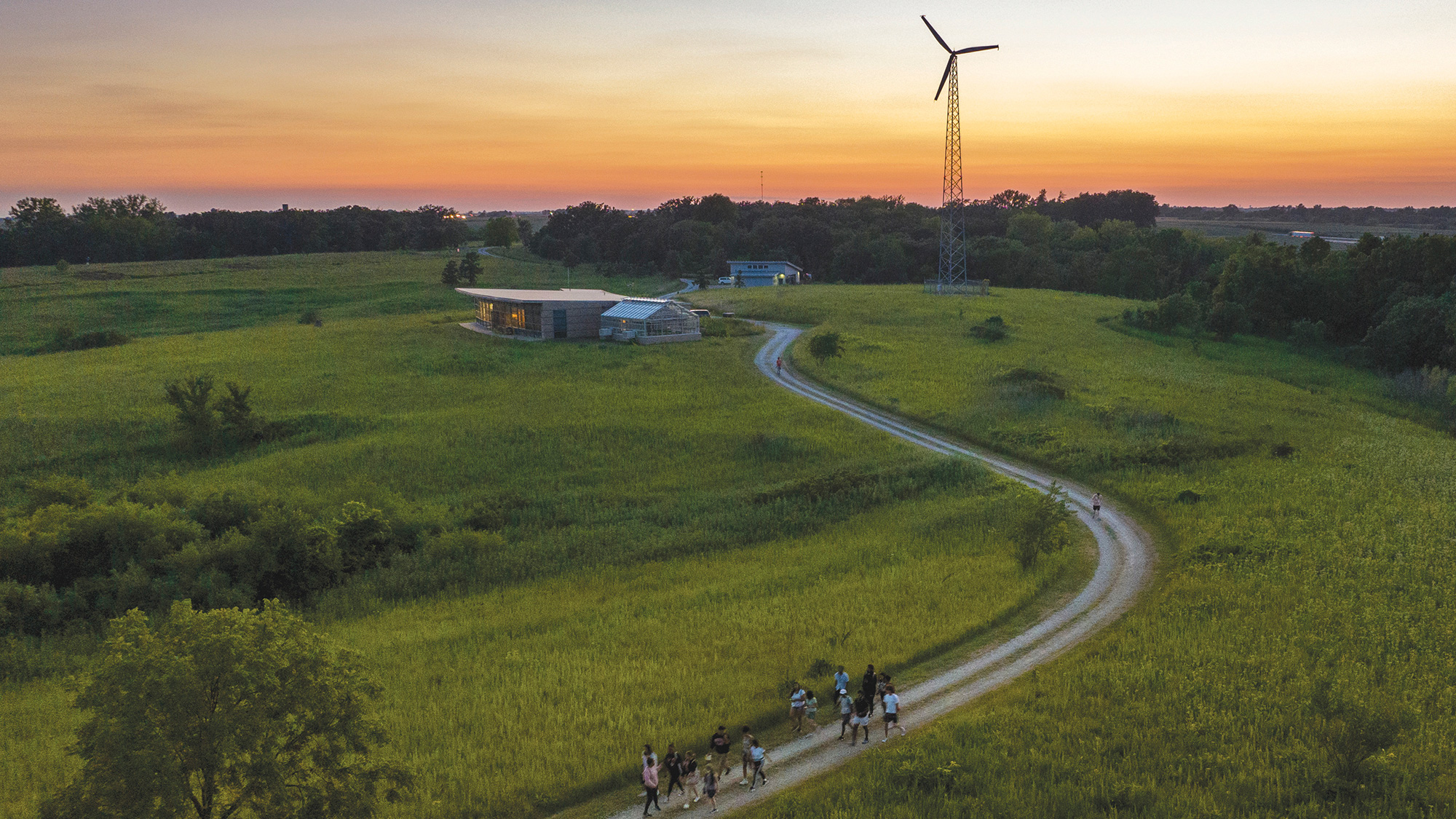Becoming Rooted: The Conard Environmental Research Area
Grinnellians have returned to those same woods ever since. Rather than hiking, these days they roll up in College vans. They still come to document the spring wildflowers, but they also come to conduct research, to write, to birdwatch, to hike, and to make art. The place, now named the Conard Environmental Research Area (CERA) in honor of its first patron, has become a meaningful destination for Grinnellians seeking to understand their place in the natural world.
An Endangered Ecosystem
The land became the College’s official property when it was bought for just $60,000 in 1968. The 365-acre mixture of farmland and pastureland is made extraordinary by the few acres of native, unplowed prairie that it contains.
Over 99.9% of Iowa’s original prairie has been erased by conventional agriculture, explains Emily Klein, CERA’s manager. The remnant at CERA belongs to the 0.1% of surviving native prairie, and the preservation and expansion of that prairie drives the space’s management.
Regular prescribed fires, native plantings, and careful invasive species management over 50 years have resulted in more than 125 acres of restored prairie, as well as a restored oak savanna and woodland and many experimental plots.
“Where Is the Prairie?”
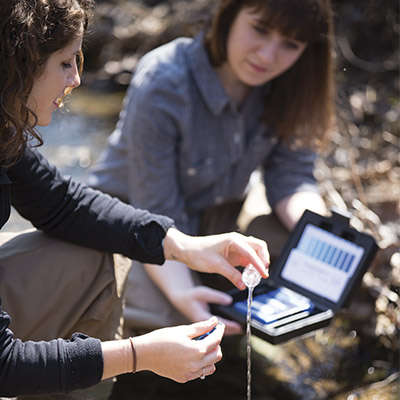 Peter Jacobson, professor of biology and current CERA director, says that over the years CERA has grown into a site not only for productive scientific research and teaching, but also a space that Grinnellians use for recreation and learning across disciplines. The construction of the Environmental Education Center (EEC) in 2005, a state-of-the-art laboratory and classroom facility, has enabled more classes, speakers, retreats, and events to make use of the setting.
Peter Jacobson, professor of biology and current CERA director, says that over the years CERA has grown into a site not only for productive scientific research and teaching, but also a space that Grinnellians use for recreation and learning across disciplines. The construction of the Environmental Education Center (EEC) in 2005, a state-of-the-art laboratory and classroom facility, has enabled more classes, speakers, retreats, and events to make use of the setting.
“We now estimate that over a third of students in a class year are using CERA during their time at the College. Increasingly, that’s not just in the context of STEM classes,” says Jacobson.
Sociology, anthropology, and art classes alike make use of the space, and eight tutorial classes visited CERA this year to be guided through the land’s history by Klein. She sees CERA as an especially important tool for students just getting oriented at college.
“A large percentage of first-year students are not from Iowa or the Midwest. They’ve never seen a landscape like Iowa’s before, and when they come to Grinnell, they’re observing a landscape that is one of the most altered ecosystems in the world,” says Klein. “CERA allows us to tell the history of that landscape and to illustrate how much has changed.” Though almost entirely wiped out but for places like CERA, the deep, fertile soils of prairie ecosystems are what first catalyzed Iowa’s transition to a hotbed of agricultural productivity.
“Students live in Grinnell, a town called ‘the jewel of the prairie.’ But where is the prairie?” Klein asks. She gestures out the windows of the EEC, toward CERA’s restored Wilson Prairie. “This is it. And it’s one of the best examples we have.”
A Seed of Belonging
Like Klein, Hai-Dang Phan ’03, associate professor of English, believes that time spent at CERA helps new Grinnellians to better connect with their new environment. He uses the place to frame tutorials that revolve around place and belonging, including his 2022 course, Birds: Nature, Joy, and Belonging.
“We are all always learning to see and to listen, or at least we ought to be, and places like CERA can help us practice these forms of attention and care,” says Phan. For the tutorial’s first birdwatching excursion, he brought students to the field station.
“I bring my students here, and I bring myself here, to cultivate a greater sense of place and belonging,” Phan says. “I would want CERA to act like a seed of belonging, dispersing, and growing elsewhere.”
For some, there is another stage: return.
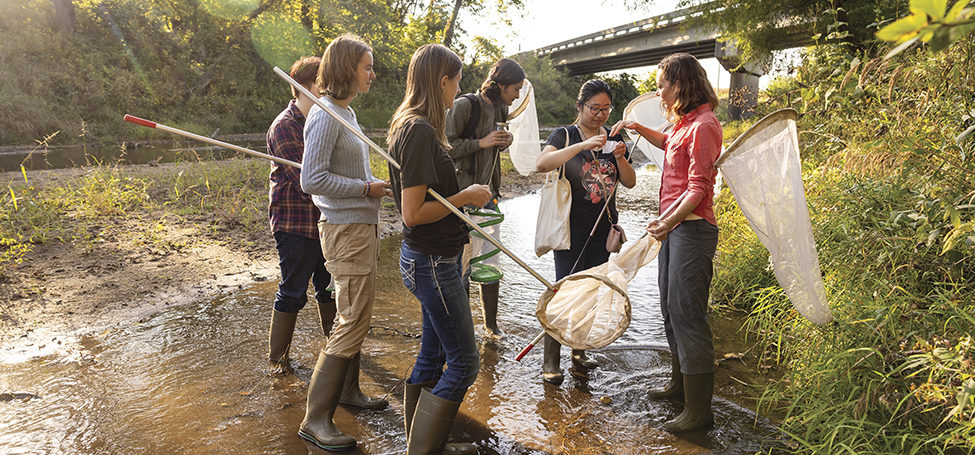 Idelle Cooper ’01 first caught the “science bug” as a student at CERA. Now a member of the biology faculty, she includes students on damselfly collection expeditions at the research station in the hopes of sparking a similar love.
Idelle Cooper ’01 first caught the “science bug” as a student at CERA. Now a member of the biology faculty, she includes students on damselfly collection expeditions at the research station in the hopes of sparking a similar love.
Coming Home to CERA
Idelle Cooper ’01 first fell in love with CERA in 1999. Professor of Biology Jackie Brown had brought students in his Evolution and Ecology class to survey the plants in the annually burned and unburnt experimental plots there. Brown tragically passed away following a car accident in 2019 while conducting research in Hawaii Volcanoes National Park, but this research, work that nearly 100 biology students contribute to each year, “totally captured” Cooper. “The idea that any of us — that I — could find something no one else has ever known … it was beautiful.”
Cooper conducted research at CERA with Brown the following summer. She credits her work there with leading to research publications, graduate school, and, eventually, a career as an evolutionary biologist. Last year, Cooper returned to Grinnell — and to CERA — as an associate professor and new member of the faculty. Of the return, she says, “It feels like coming home.”
Cooper brought her Introduction to Biological Inquiry class to CERA this fall and cannot wait to introduce future students and establish her own research projects at the field station. It’s important to her that students see the full range of Iowa’s landscapes, beyond corn and soybeans. “I think if students can appreciate and value where they are while they’re here in Iowa, then they can take ability with them, and they can do that wherever they are,” says Cooper.

Bridge construction projects led by Emily Klein and Jake Hill (pictured) have vastly expanded CERA’s trail system. Improved access to the research area means more opportunities for recreation, research, and reflection.
“CERA feels richer and more mature as a prairie now than it did when I was here before. Both because it really is a more established ecosystem, but also because it now represents a lot from my own history,” says Cooper. “Having been a student and now faculty, I feel like this is one of our greatest assets.” It’s a sentiment she shares with many faculty.
Getting Grounded
Andrew Graham has taken groups of students to CERA since first joining the Grinnell faculty in 2012. As a geoscientist, the associate professor of chemistry and environmental studies is often encouraging students to look down while out at the field station, to get their feet wet and their hands dirty — literally. From the tallgrass roots that break down into soil rich in organic matter, to the minerals that collect at the base of Perry Pond, the ground at CERA is ripe for exploration, Graham says.
“The tactile experience of putting your hands in the muck and picking it up and feeling the grit of the sand and the smoothness of the pebbles, those sensory experiences can result in a kind of contemplation about the way that the world works that’s difficult to achieve in the classroom alone,” Graham explains. “You understand something about yourself and your place in the world by really close observation of what might be considered the mundane.”
Ultimately, this understanding is the goal behind all of Graham’s class trips to the field station. “When I bring students to CERA, I want them to gain a sense that their home extends beyond just the Grinnell campus.”
Restoring the Past and Planning for the Future
It’s an exciting time at CERA. “There’s a lot going on in terms of increasing access and making it a facility of even broader use at the College,” Jacobson explains. Year round, student assistants and summer interns work with Klein and Jake Hill, CERA’s horticulturist, to fight invasive species in the restored plots and to expand access to the property. They’ve broadened CERA’s trail system to reach previously inaccessible areas of the property and have built bridges by hand that span creeks and ditches. Their work has not only extended the trails available for recreational use, but it’s also made accessible huge swaths of land that can now be managed and restored to prairie.
Using seeds harvested from CERA’s prairie remnant, Klein and Hill have plans to expand the remnant bit by bit. The process will create interesting experiments for Grinnell, says Jacobson. “We can ask, for example, how long does the replanted land take to reorganize itself and how long does it take for agricultural effects to fade from the system?”
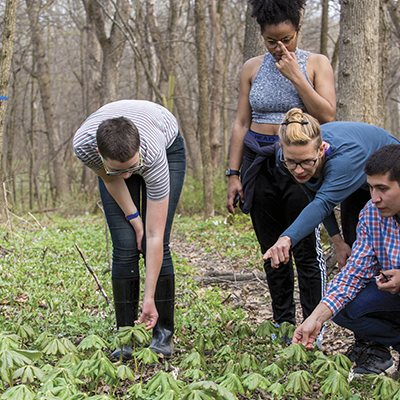 A new solar array has made the EEC a carbonneutral facility, and plans are underway to renovate the old Benjamin Graham Lab into a residence for visiting artists, writers, and scientists. The residence and its sweeping views of the pond and prairie will offer a new way to embed people into the natural space, says Klein. And as she sees it, the more Grinnellians who engage with CERA — and the more frequent their engagement— the better.
A new solar array has made the EEC a carbonneutral facility, and plans are underway to renovate the old Benjamin Graham Lab into a residence for visiting artists, writers, and scientists. The residence and its sweeping views of the pond and prairie will offer a new way to embed people into the natural space, says Klein. And as she sees it, the more Grinnellians who engage with CERA — and the more frequent their engagement— the better.
CERA is a laboratory for student and faculty learning, say Klein and Jacobson, but it’s also an experimental ground for much more. “CERA gives us an incredibly important pedagogical opportunity,” Jacobson says. “Iowa is at the epicenter of so many global challenges. How do we manage increased agricultural production while protecting natural lands? How do we manage air, water, soil? How do we do it sustainably? These are issues that the world is facing. There’s no better place to engage with these questions than at CERA. Because we’re at the frontlines of it all.”
Support from Alums Helps CERA Grow
The expansion of infrastructure and learning spaces at the Conard Environmental Research Area (CERA) over the last decades has been made possible by countless alumni donors.
The Christiansen Laboratory, the Environmental Education Center’s primary learning space, was funded by gifts from Anne Campbell Spence ’66, Karen Van Dusen ’77, and Joel Spiegel ’78, in honor of Professor Emeritus of Biology Ken Christiansen, who passed away in November 2017. Van Dusen and Spiegel also partially funded the recent solar array project, while a generous gift from an anonymous alumni donor has kickstarted the renovation of the Benjamin Graham Lab residence.
Alumni interested in providing philanthropic gifts to grow CERA and students’ experiences there can request that their donations to the College be designated to support CERA.
“Students live in Grinnell, a town called ‘the jewel of the prairie.’ But where is the prairie This is it. And it’s one of the best examples we have.”
— Emily Klein
